2020江苏省常州市中考英语真题及答案
一、单项选择
1. Take it easy. There will be
two buses coming in a few minutes.
A. another
other
B. other
C. others
D. the
2. Millie’s research paper isn’t up to standard
she has worked at it
for two weeks.
A. since
although
B. unless
C. if
3. To the west of our school
some bookstores and a park.
A. lies
have
B. lie
C. has
D.
D.
4. —Were you required
home during the outbreak of COVID-19?
—Yes. Luckily, the Internet made it possible for many of us
from home.
A. to stay; to work
staying; work
B. staying; to work
C. to stay; work
D.
5. —Jim, turn down the music. Our baby is sleeping.
—Don’t worry. He
for half an hour.
A. woke up
been awake
B. has woken up
C. was awake
D. has
6. Jenny’s parents were completely_
when they saw the
changes in her.
A. surprising; amazing
B. surprised; amazing
C. surprising; amazed
D. surprised; amazed
7. A factory will be built for the
of this type of new energy car.
A. position
pronunciation
B. population
C. production
D.
�
8. To my joy,
we
go to the bank. Mary has lent us some money.
A
shouldn’t
B. needn’t
C. couldn’t
D. wouldn’t
9. A great deal of my
time is
with practicing playing the guitar.
A. taken up
B. made up
C. put up
D. set up
10. —Do you want to try some wild duck?
—
. We should protect wild animals.
�
A. No idea
B. No problem
C. No way
D. No doubt
二、完形填空
A window is a common but powerful tool — a patch(小块) of the world, from which our body
is separated.
The only thing we can do is look. You have no 11
may make an
on what you will see. However, your brain
assumption(猜想) out of whatever happens to appear.
One day, I was taking a nap(小睡) in my office when I woke up to the 12
of a car
crash. I looked out of my window. A car had just backed into a fence(围栏)and damaged (毁
坏〉it.
The driver got out of the car
once.
He was short without hair on his head. I
13
him at
To my surprise, the man tried to
14
the damage he caused. However, his
efforts all failed. Once he even funnily fell onto the road when trying to pull the fence. I
15
a lot. The failure of this terrible man was
brightening my whole day.
About 10 minutes later, the man left.
That, I thought, would be the
16
of his efforts. The man — that villainous(可憎
的) man — was going to
17
all the mess behind for someone else to clean up.
But this is the
18
of windows. They contradict(与…矛盾)your easy assumptions.
The man appeared a few minutes later with some
watched out of my window as he kept on fixing the fence
19
20
. For the next hour, I
it was extra safe,
stronger than before.
This man was a hero. My
21
assumptions, I realized, were all about
myself. I would be
22
and run away if I came across such a messy
situation.
My window had woken me up from a nap to teach me a lesson, a lesson that changed my whole
day and even
my whole life.
11. A. agreement
B. influence
C. discovery
12. A. symbol
B. sight
C. sound
D.
impression
D. sign
13. A. accepted
B. remembered
C. disliked
D. greeted
�
14. A. confirm
B. avoid
15. A. complained
B. laughed
C. cover
C. learnt
D. repair
D. thought
16. A. end
17. A. hide
18. A. quality
19. A. friends
B. fun
B. push
B. shame
B. tools
C. problem
D. lesson
C. move
C. power
C. medicines
D. leave
D. truth
D. plans
�
20. A. until
B. when
C. after
21. A. ugly
B. friendly
C. proper
22. A. encouraged
B. pleased
C. scared
三、阅读理解
D. since
D.
possible
D.
relaxed
With so much free time on our hands during lockdown, many of us have entertained the idea
of knowing more about the world. Learning a foreign language is a good choice. Here are a few
examples, in order of time it takes people to learn them.
Latin languages (about 600 hours)
The popular Latin languages — Italian, French, Spanish and Portuguese — require about
600 hours to learn. Of these, Spanish and Italian are the easiest for English speakers to
learn. They are followed by Portuguese and finally French.
Latin languages share many words with English. However, those shared words look or sound
similar, but have different meanings over time.
Greek (1,100 hours)
Modern Greek is maybe the easiest language to learn that uses a different alphabet( 字
母 表 ). It is also a language that has contributed many words to English. Indeed, the
president of Greece once gave two speeches at an international meeting that included just
Greek loan words(外来词) as well as the unavoidable basic English.
Japanese (2, 200 hours)
Counting objects in Japanese depends on whether they are long and thin (like “roads”),
small and round (like “apples”), thin and flat (like “sheets of paper”), and hundreds
more examples.
What Japanese you speak also depends on your gender(性别). There’s a “rough” language
for men and a more
“ladylike” language for women, but you must understand both.
Chinese (2, 200 hours)
Each Chinese written word is hardly understandable when spoken between a Mandarin (普
通话) speaker in Beijing and a Cantonese speaker in Guangdong. If you think that's strange,
consider our number system: the symbol “2” is widely understood but it’s pronounced
“two” in English and “duex” in French.
�
23. For an English speaker, which of the following is the easiest to learn?
A. Japanese.
B. French.
C. Greek.
D. Italian.
24. What can we learn from the passage?
A. The same word in two languages always has the same meaning.
B. The English language and the Greek language use the same alphabet.
�
C. Objects are counted differently in Japanese according to their shapes.
D A Mandarin speaker and a Cantonese speaker write Chinese differently.
25. The purpose of this passage is to tell English speakers .
A. how to learn some foreign languages
B. why they must learn a foreign language
C. some information on the difficulty of foreign languages
D. not to choose an Asian language to learn as it is too hard
Influenza, or flu(流感), is a type of virus. It spreads from one person to another
quickly. When someone who has the flu coughs or sneezes, little droplets from their lungs
( 肺 ) spread out into the air. Anyone nearby can get sick. Even a person who touches
something with the virus and then touches his or her mouth, eyes, or nose, can become
infected(感染).
The outbreak of the 1918 influenza infected about 500 million people worldwide. It killed
from 20 million to 50 million people. It was first seen in Europe, the United States, and
parts of Asia. It then spread quickly around the world. Many people who became sick were
young, healthy adults. At the time, no treatments worked in the prevention of the spread of
the killer flu. People were ordered to wear masks. Schools, theaters and other public places
were closed.
When the first wave(波〉in the spring of 1918 hit, it didn't seem serious. People who were
infected felt the
usual flu symptoms(症状 ), which are chills, fevers, and feeling tired. Those who got sick
generally got better after several days. Not many died. However, a second, highly
contagious( 传 染 的 )wave of influenza appeared in the fall of that same year. Victims died
shortly after they were infected — within hours or days. Their skin turned blue and their
lungs were filled with liquid(液体), making it very difficult to breathe.
By the summer of 1919, the flu pandemic(大流行病) came to an end. Sick people had
either got well or died. Almost 90 years later, in 2008, researchers announced they’d
discovered why the 1918 flu was so deadly. The flu virus inflamed (使…恶化)the lungs,
causing them to fill with liquid.
Since 1918, there have been several other influenza pandemics, although none has been
quite as deadly.
�
26. What information about the 1918 flu is mentioned in the passage?
A. The reason why it was so deadly.
B. The reason why it ended.
C. The change it caused to medical research.
D. The place in which it was last seen.
�
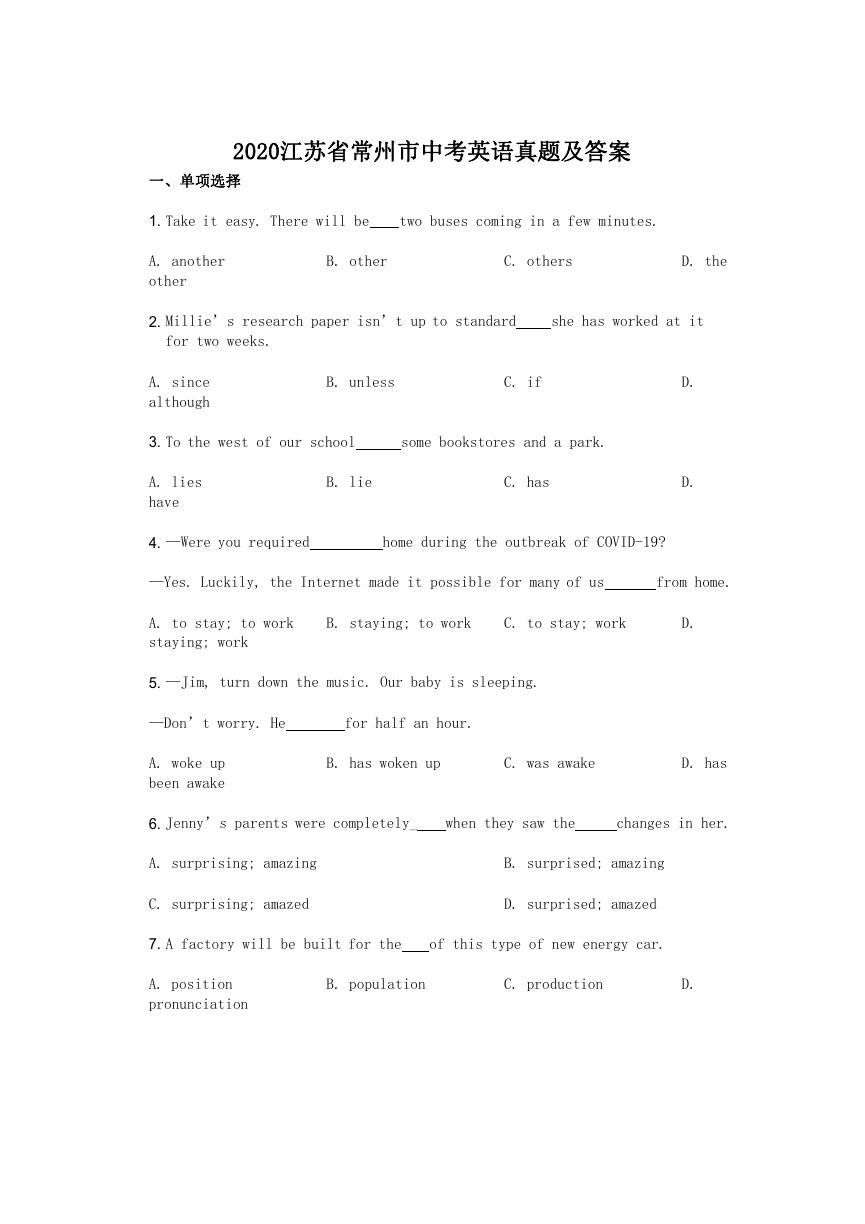
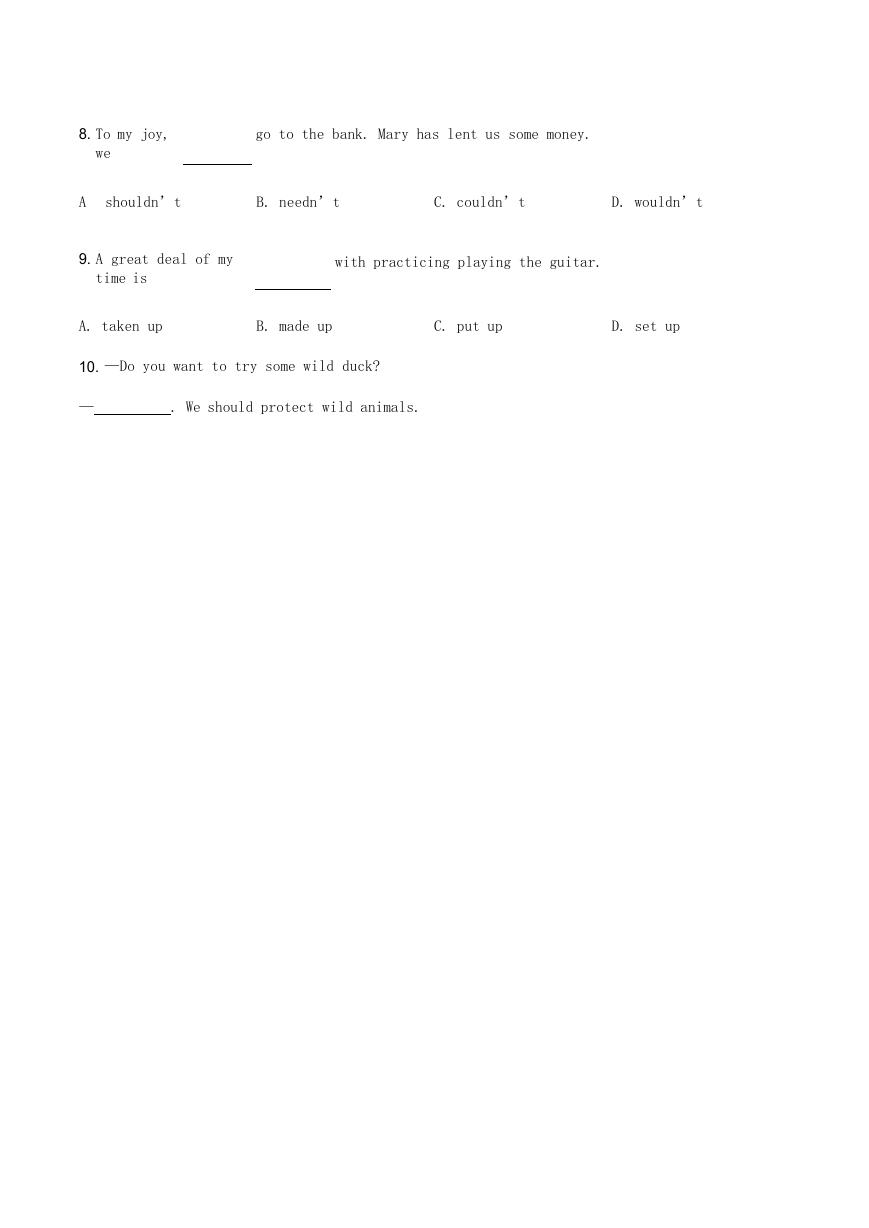


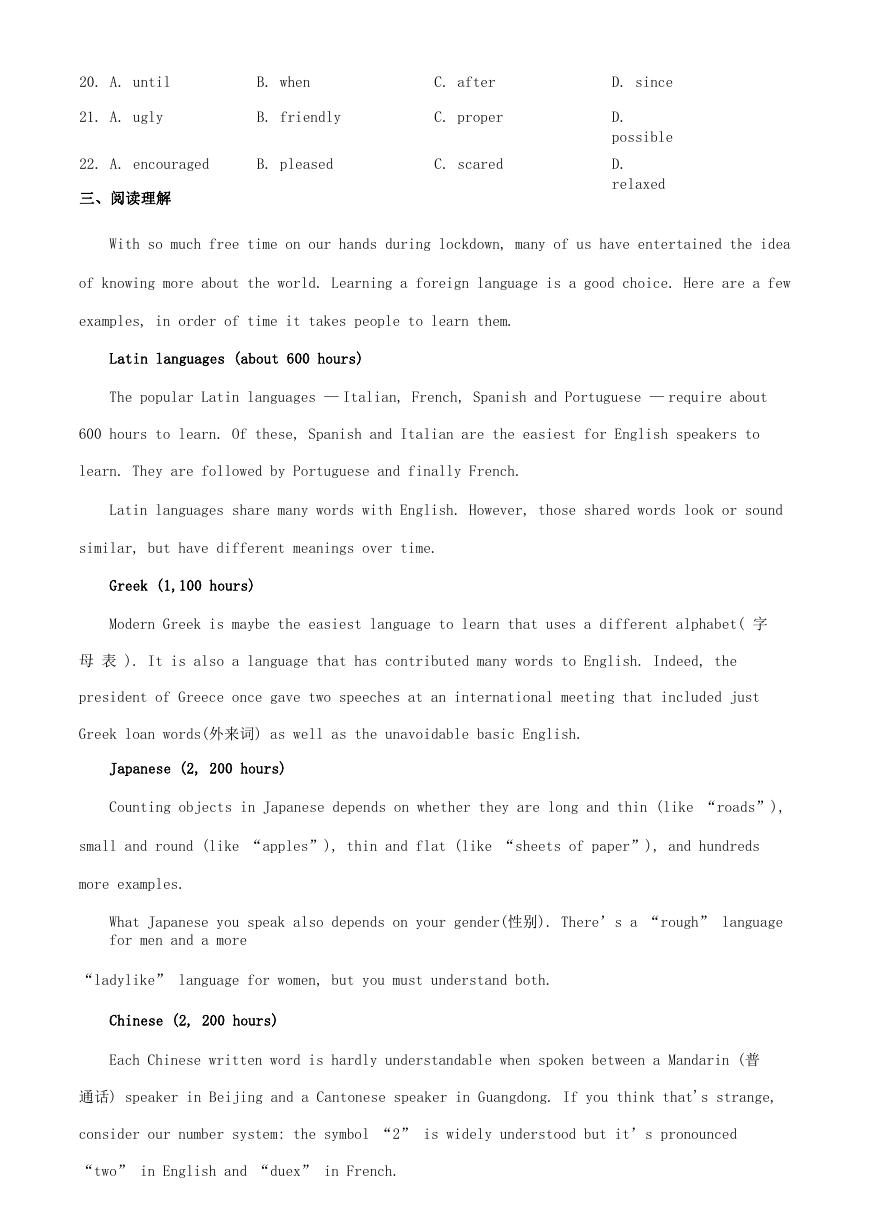
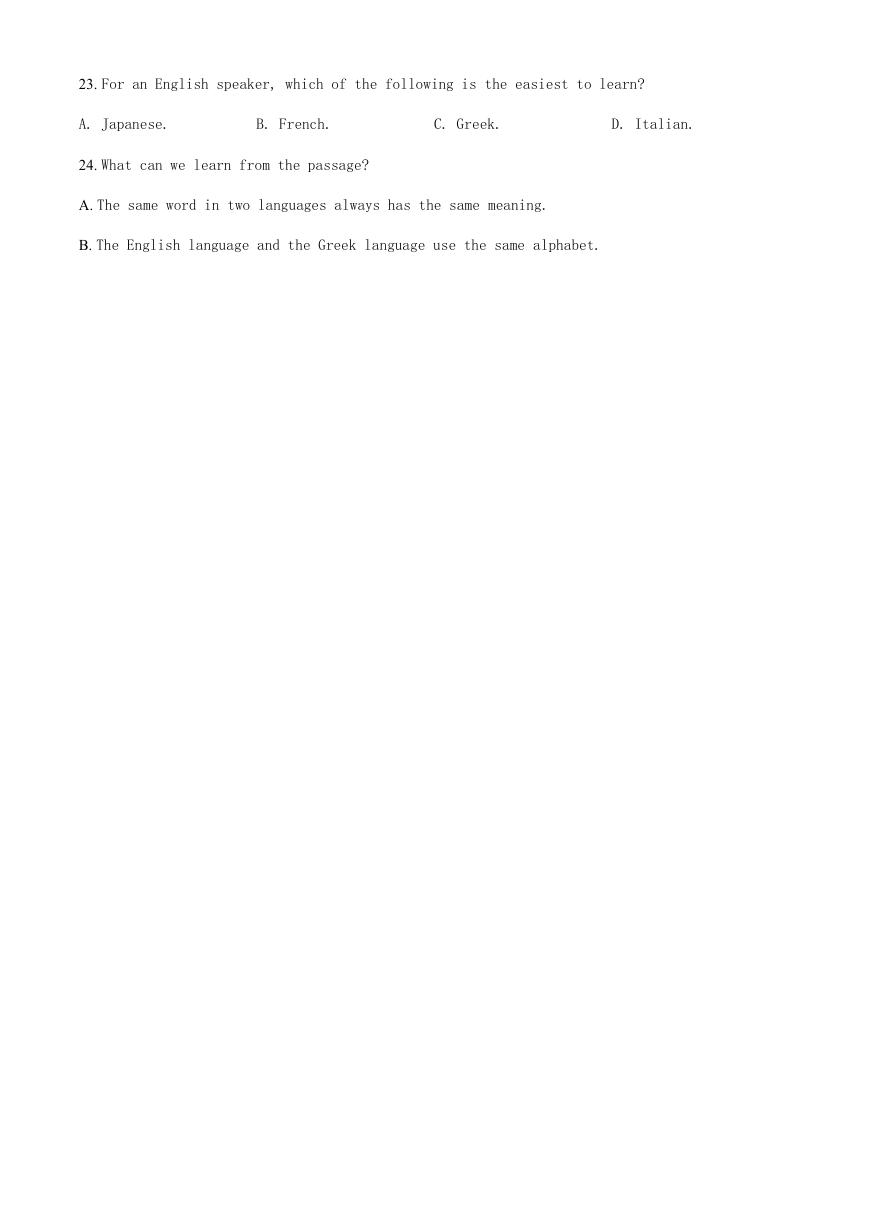
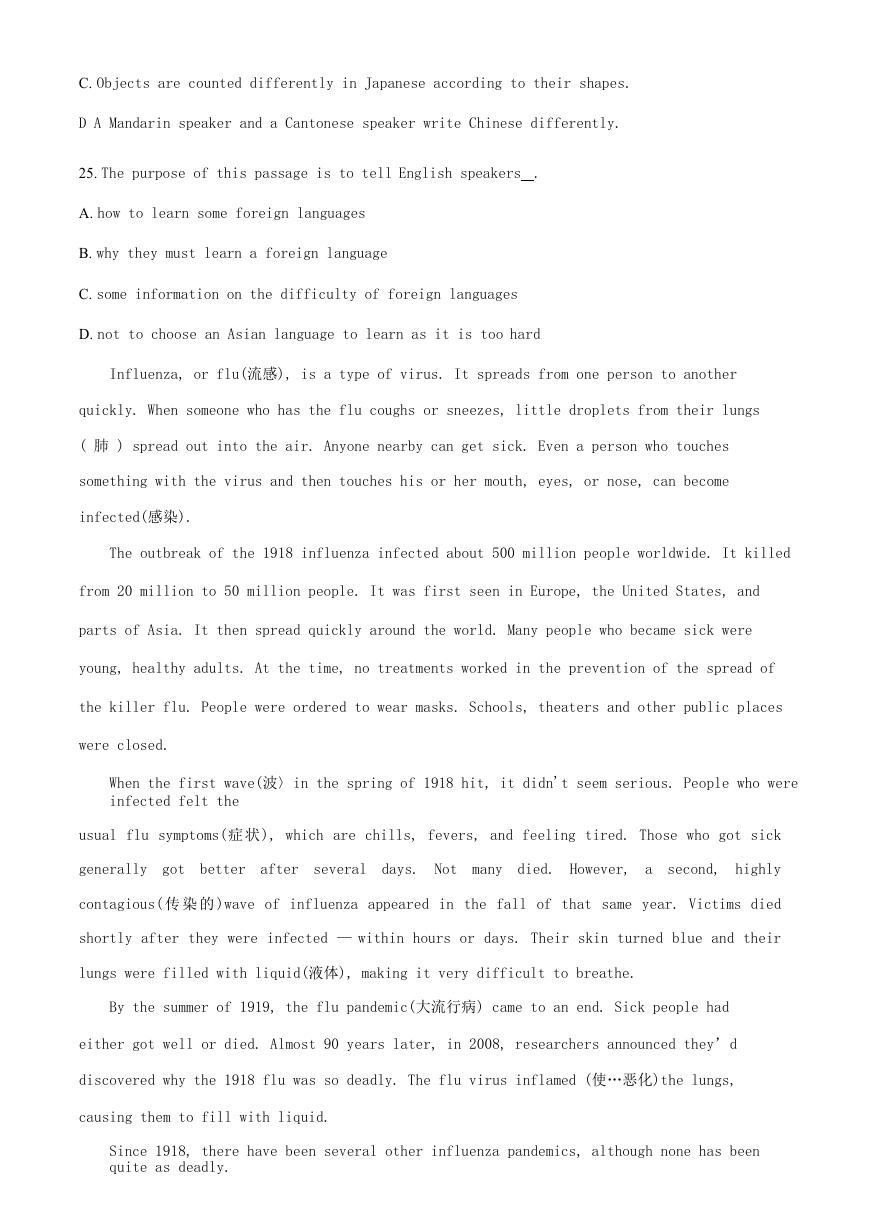









 2023年江西萍乡中考道德与法治真题及答案.doc
2023年江西萍乡中考道德与法治真题及答案.doc 2012年重庆南川中考生物真题及答案.doc
2012年重庆南川中考生物真题及答案.doc 2013年江西师范大学地理学综合及文艺理论基础考研真题.doc
2013年江西师范大学地理学综合及文艺理论基础考研真题.doc 2020年四川甘孜小升初语文真题及答案I卷.doc
2020年四川甘孜小升初语文真题及答案I卷.doc 2020年注册岩土工程师专业基础考试真题及答案.doc
2020年注册岩土工程师专业基础考试真题及答案.doc 2023-2024学年福建省厦门市九年级上学期数学月考试题及答案.doc
2023-2024学年福建省厦门市九年级上学期数学月考试题及答案.doc 2021-2022学年辽宁省沈阳市大东区九年级上学期语文期末试题及答案.doc
2021-2022学年辽宁省沈阳市大东区九年级上学期语文期末试题及答案.doc 2022-2023学年北京东城区初三第一学期物理期末试卷及答案.doc
2022-2023学年北京东城区初三第一学期物理期末试卷及答案.doc 2018上半年江西教师资格初中地理学科知识与教学能力真题及答案.doc
2018上半年江西教师资格初中地理学科知识与教学能力真题及答案.doc 2012年河北国家公务员申论考试真题及答案-省级.doc
2012年河北国家公务员申论考试真题及答案-省级.doc 2020-2021学年江苏省扬州市江都区邵樊片九年级上学期数学第一次质量检测试题及答案.doc
2020-2021学年江苏省扬州市江都区邵樊片九年级上学期数学第一次质量检测试题及答案.doc 2022下半年黑龙江教师资格证中学综合素质真题及答案.doc
2022下半年黑龙江教师资格证中学综合素质真题及答案.doc